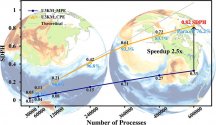- Researchers in Shanghai say they have developed a chiller using a plentiful isotope to create super-cold temperatures
- But more work needs to be done before it can be used in mass applications
in Beijing
Published: 10:00pm, 2 Apr, 2022
Updated: 10:00pm, 2 Apr, 2022
Researchers in Shanghai say they have developed a device to create extremely low temperatures that would make cutting-edge technology such as quantum computers more widely available.
The core components of most quantum machines – from computers to satellites – detect and manipulate subatomic particles that are easily disturbed by heat so must operate in conditions near absolute zero.
Cooling the most advanced quantum hardware requires helium-3, an isotope of helium that can carry heat away with unmatched efficiency.
But helium-3 is extremely rare on Earth and the main supply is from ageing nuclear warheads.
The demand for helium-3 in quantum research and other disruptive technology has soared. In less than two decades its price has risen more than 40-fold to over US$5,000 per litre in gas form.
But even then not just anybody can buy it. In the United States, for instance, helium-3 is one of the few commodities that is subject to strict government production and distribution controls on military grounds.
In a paper published in domestic peer-reviewed
Science Bulletin on Wednesday, Professor Dang Haizheng and his colleagues with the Shanghai Institute of Technical Physics at the Chinese Academy of Sciences, said they had built a powerful chiller for some of the most demanding quantum machines without using any helium-3 at all.
The new cooling device uses helium-4, another helium isotope as its coolant.
When approaching temperatures as low as 2 kelvin (-271 degrees Celsius), helium-4 turns into a superfluid, climbing walls regardless to gravity and becoming much more difficult to control.
Dang’s team developed a theoretical model that could, to some extent, predict the behaviour of helium-4 flow in a superfluid state.
The chiller they built works in principle similar to a household fridge but has few moving parts. It is driven by a pulse energy source and operates in high frequency to increase heat-transfer efficiency.
To tame the helium-4’s erratic behaviour, the chiller has a special component to stop the antigravity climb.
Part of the device must also be built with extremely high quality components with precision twice as high as mainstream products today, according to the researchers.
In their experiment, the new cooling device kept a superconducting nanowire single-photon detector, an optical sensor commonly used in quantum machines, at a temperature of 1.8 kelvin for more than two weeks (15 days).
The results suggested that the helium-4 had potential to completely replace helium-3 even in some most demanding applications such as a space mission, said the researchers.
“This is great news,” said a quantum physicist in Hefei, Anhui province, who declined to be named.
Finding a helium-3 substitute could reduce the cost of quantum technology in radars by at least 10 per cent, according to the researcher’s rough estimate.
Using helium-4 would help remove a major constraint to the mass application of quantum technology, but the reliability of the new cooling device remains a question because the experiment was conducted in a laboratory.
“A good product must work for years without a flaw in harsh environments,” he said.
China has made a significant contribution to the development of quantum technology in recent years.
With government funding, Chinese researchers have built the world’s first quantum satellite, longest quantum communication network, farthest-ranging quantum radar and fastest quantum computers.
All these developments were using sensors cooled by helium-3. But the real-life application of these technologies remains limited.
Some Chinese researchers, including Dang’s team, have launched their own start-ups to speed up the commercialisation of the technology with a mix of government and private funding.

